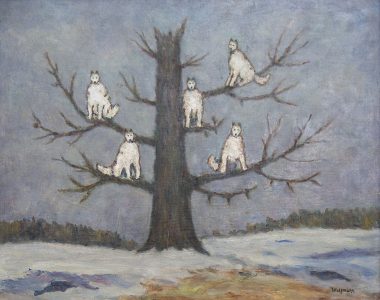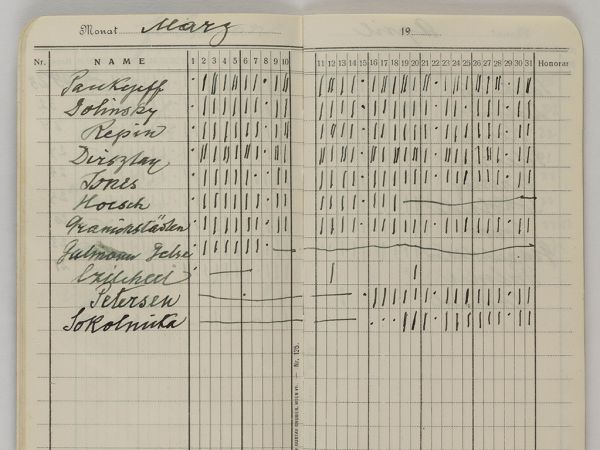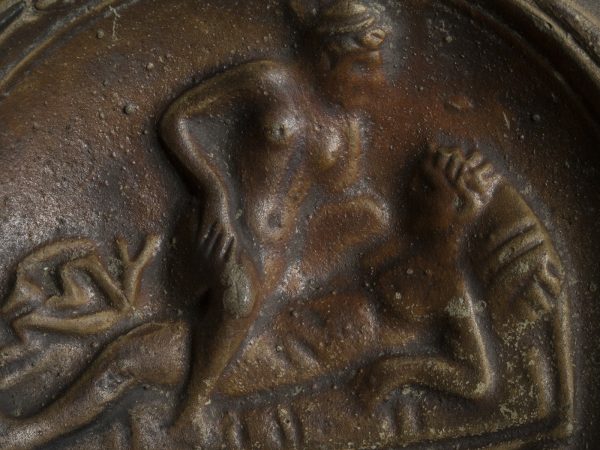Sergei Pankejeff's nightmare occurred the night before his fourth birthday.
It brought with it the end of his ‘naughty phase’ and the start of a period of intense anxiety.
 Here is how he described it to Freud:
Here is how he described it to Freud:
“I dreamt that it was night and that I was lying in bed. Suddenly, the window opened of its own accord, and I was terrified to see that some white wolves were sitting on a big walnut tree in front of the window. There were six or seven of them. The wolves were quite white, and had big tails and had their ears pricked like dogs when they pay attention to something. In great terror, evidently of being eaten up by the wolves, I screamed, and woke up.”
For Freud, a dream is an ultra-condensed collage of thoughts.
His theory of dreams makes a crucial distinction between the manifest content (the dream as we remember it) and the latent content or ‘dream thoughts’. The latent thoughts are combined together into the manifest content by an unconscious process of ciphering.
Freud’s aim was to bring out the wishes hidden in the latent content. He did this by asking his patients what came to mind in relation to each element of the dream.
Freud’s questions to the Wolf Man
The feature below is intended to give you a sense of Freud’s method.
Each heading is a question Freud asked Pankejeff about the dream, along with Pankejeff’s answer and some questions to consider.
We have slightly adapted the original text and added a few extra headings based on the case material.
-
Why were the wolves white?
-
“This makes me think of sheep. My father used to take me to look at the sheep near our house, and this made me very happy. He was a very kind man and would often play with me, and sometimes he would playfully threaten to gobble me up.
Shortly before I had the dream, an epidemic had broken out. My father had had the sheep inoculated, but this caused even more of them to die.”
Questions:
- What does this association tell us about Pankejeff’s relationship with his father?
- Do you think there is any significance to his father’s playful threat to gobble him up?
-
Why was there a tree?
-
“This makes me think of a Christmas tree. I had the dream the night before Christmas, which is also my birthday.
I was probably anticipating my double quantity of presents as I fell asleep. At some point in the night, the presents turned into… wolves.”
Questions
- Why is it important to children that their parents give them what they want for Christmas?
- For Freud, our dreams fulfil our wishes. What wish might be being fulfilled here?
- Why might a proof of love suddenly turn into a cause of anxiety?
-
Why were the wolves' ears pricked?
-
“At the time I was tremendously afraid of a picture of a wolf in a book of fairy stories. The picture was from Little Red Riding Hood. In the picture, the wolf was standing upright, with its claws out and its ears pricked. My elder sister used to tease me by holding the picture up in front of me, which would make me scream.
I was a very quiet child, but my sister was lively and mischievous. My parents used to say that I should have been born the girl and she the boy.
Later on it became obvious that she was our father’s favourite, and I was devastated. Many years later she killed herself, and I hardly felt a trace of grief.”
Questions
- Do you think fairy stories can have a psychological impact on children? Why?
- What happens in the story of Little Red Riding Hood?
-
Why did the wolves have big tails?
-
“I remember a story about a wolf that wanted to go fishing in the winter. He used his tail for bait, and it was snapped off in the ice.
Around this time I also remember being given some sugar sticks, which our nanny said were chopped up snakes. When walking with my father we had once found a snake, and my father had beaten it to pieces with a stick.
Shortly before this, my father had taught me the names by which horses are distinguished, according to whether their sexual organs are intact or not.”
Additional material
Pankejeff told Freud his two earliest memories:
- His nanny was walking in front of him and said: “Do look at my little tail!”
- His nanny’s hat being blown away by a gust of wind
Questions
- What do you think the wolves’ tails represented?
- If you were Freud, how would you have responded to this association?
-
Why were the wolves in the tree?
-
“My grandfather used to tell a story about a tailor who was sitting at work when a wolf leapt in through the window.
The tailor managed to pull the wolf’s tail off, and it ran away in terror. Some time later the tailor went into the forest, and had to climb a tree to escape from a pack of wolves. The tail-less wolf was amongst them and wanted revenge, so it told the other wolves to climb upon one another to reach the tailor.
The tailor, recognising the wolf, cried out: ‘catch the grey one by his tail!’ The wolf, terrified by the recollection, ran away, and all the others tumbled down.”
Questions
- Have you noticed any recurring themes in Pankejeff’s associations?
- Why do you think this childhood memory stayed with Pankejeff into adulthood?
-
Why were there six or seven wolves?
-
“This makes me think of the story of The Wolf and the Seven Little Goats, where the wolf deceives the goats into letting him into the house by turning his paws white and imitating their mother’s voice.”
Additional material
Pankejeff’s mother suffered from a bowel condition. As a child, he overheard her telling her doctor: “I can’t go on living like this.” In his analysis with Freud, he repeatedly used these exact words to describe his own intestinal problems.
Questions
- This is the second piece of material from a fairly tale to come up in Pankejeff’s associations (the other was about Little Red Riding Hood). Are there any connections between the two stories?
- Is there an identification being expressed in this material?
Discover more:

Previous chapter
The Analysis Begins
As Freud's analysis of Pankejeff progressed, a curious story began to unfold.
